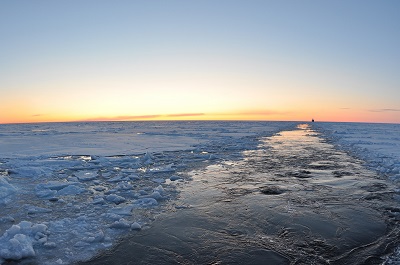Arctic Shipping is Not China's New Silk Road
 Despite all the global attention the potential for Arctic shipping is receiving, Malte Humpert, executive director of The Arctic Institute believes things may not pan out as some expect.
Despite all the global attention the potential for Arctic shipping is receiving, Malte Humpert, executive director of The Arctic Institute believes things may not pan out as some expect.
Every time Arctic sea ice extent reaches a new record low a host of new reports and studies predict a rapid increase in shipping activities in the Arctic, he says. Expectations are high that Arctic shipping routes, particularly the Northern Sea Route, will rival traditional shipping routes and complement the Suez Canal route as a key waterway for trade to and from Asia by the middle of this century.
One of the drivers of Arctic shipping, as the logic goes, is China’s rapidly growing international trade. As China aims to diversify its trade routes and reduce its dependence on trade passing through the Strait of Malacca, the Arctic offers an alternative and shorter route to conduct part of its trade. How realistic are such scenarios?
.jpg) Trans-Arctic shipping is most viable where it offers a significant shortcut in comparison to traditional trade routes. In the case of China, this applies only to its trade with Europe, especially Central and Northern Europe. Trade with all other regions, including Africa, the Americas, and the Middle East, will not be routed though the Arctic even if ice-free periods were to increase dramatically. China’s existing trade patterns offer little opportunity to take advantage of Arctic distance savings. Its major trade routes are far removed from the Arctic as most of its imports arrive from its direct neighbors, such as Japan and South Korea, or from countries near to or south of the equator, such as Australia and Brazil.
Trans-Arctic shipping is most viable where it offers a significant shortcut in comparison to traditional trade routes. In the case of China, this applies only to its trade with Europe, especially Central and Northern Europe. Trade with all other regions, including Africa, the Americas, and the Middle East, will not be routed though the Arctic even if ice-free periods were to increase dramatically. China’s existing trade patterns offer little opportunity to take advantage of Arctic distance savings. Its major trade routes are far removed from the Arctic as most of its imports arrive from its direct neighbors, such as Japan and South Korea, or from countries near to or south of the equator, such as Australia and Brazil.
Trade with Northern Europe, the region most relevant to Arctic shipping, accounts for just 2.9 percent of China’s international trade. Over the next two decades Chinese trade within the Asia-Pacific region and with countries in the southern hemisphere will experience the sharpest growth. Africa and Latin America will be supplying a growing share of China’s commodity needs.
 The importance of Europe as one of China’s major trading partners, on the other hand, will decline over the coming decades. In fact, China has been investing heavily in port infrastructure throughout Asia, the Middle East, Africa and Europe and has built an extensive network of ports in which it holds a stake. None of these investments point to the Arctic being considered as a new transportation corridor.
The importance of Europe as one of China’s major trading partners, on the other hand, will decline over the coming decades. In fact, China has been investing heavily in port infrastructure throughout Asia, the Middle East, Africa and Europe and has built an extensive network of ports in which it holds a stake. None of these investments point to the Arctic being considered as a new transportation corridor.
China’s Ocean Shipping Company (COSCO) has shown little interest in Arctic shipping as it continues to invest heavily in ports along the Suez Canal route. After more than a decade of delays, a new generation of Ultra Large Container Ships (ULCS), about twice the size of existing vessels, is about to enter into service. As container ships are becoming increasingly larger to take advantage of economies of scale, draft and beam restrictions will prevent a growing share of the global merchant fleet to transit the northernmost ocean along the NSR.
Furthermore, the absence of major ports throughout the Arctic Ocean makes it impossible for operators to benefit from network economics. A similar trend can be observed in the bulk-shipping sector. As in the container shipping business, economies of scale allow for the transport of raw materials over vast distances at ever-decreasing rates. Specialized Arcticmax
ships will be unable to compete with these new realities.
Future shipping in the Polar region will mostly consist of seasonal destinational transport, delivering supplies into the Arctic for its increasing economic activity and transporting the region’s natural resources to markets in East Asia. Apart from these niche opportunities, Arctic shipping routes will be unable to compete with the world’s existing major trade routes. Thus, while climate change will, over the coming decades, transform the frozen north into a seasonally navigable ocean, Arctic shipping routes will not become a new silk road for
China.
A full report by Humpert can be read here
Photo Credits: The Arctic Institute, US Coast Guard, U.S. Geological Survey/ Patrick Kelley
